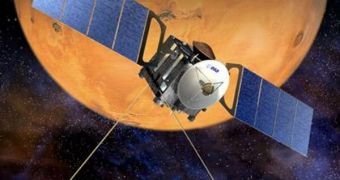Keeping in touch with landers, rovers and orbiters on the Red Planet is not as easy as it may seem. From time to time, the connection goes down for weeks, as the Sun moves in between the two planets, making any sort of radio communications impossible. When this is not the case, the star can still scramble or alter the signals considerably, leading to misinterpretation on one or both ends of the line. An expert from the European Space Agency (ESA), working together with colleagues in the United Kingdom, is now proposing a new method of keeping in touch with assets on Mars.
The two main elements in the new idea are continuously-firing ion thrusters – of the type currently in use on ESA's GOCE satellite and NASA's Dawn probe, which is powered by three DS1 heritage xenon ion thrusters – and a new type of orbit. The latter will not be an “A Orbit,” of the type based on natural laws, but a “B Orbit,” which will absolutely need electric ion propulsion to compensate for the planet's gravitational pull. The peculiar orbit will take the pair of communication relay satellites making up the system very close to Mars' surface, and a constant force is required to keep them aloft.
The goal of the new configuration is to break the limitations of natural “conjunction,” the phenomenon that sees Earth, the Sun and Mars aligned. The event occurs every 780 days, and prevents voice, data and video signals from being transmitted from one location to the other. This could have disastrous consequences for future Mars exploration, cutting off an outpost from Mission Control, and endangering lives. The proposal, called “Non-Keplerian Orbits Using Low Thrust, High ISP Propulsion Systems,” was presented at the 60th International Astronautical Congress (IAC), in Daejeon, South Korea. The IAC is the world's largest and most important space-related event.
“Traditional thrusters use a lot of fuel, so we only fire them for short periods to kick the satellite into a new, free-flight orbit. It is prohibitively expensive in terms of weight to equip a satellite with continuous thrust capability. But a solar electric propulsion system uses electricity generated from sunlight to emit chemical ions, giving a tiny thrust – about the same force that you feel if you blow on your hand – but over time, it's enough to move almost anything. ESA's SMART-1 got to the Moon in 2004 after 16 months using ion propulsion; its thruster only generated 0.2 millimeters per second per second of acceleration, but that's sufficient!” ESA European Space Operations Center (ESOC) expert Francois Bosquillon de Frescheville says.

 14 DAY TRIAL //
14 DAY TRIAL //